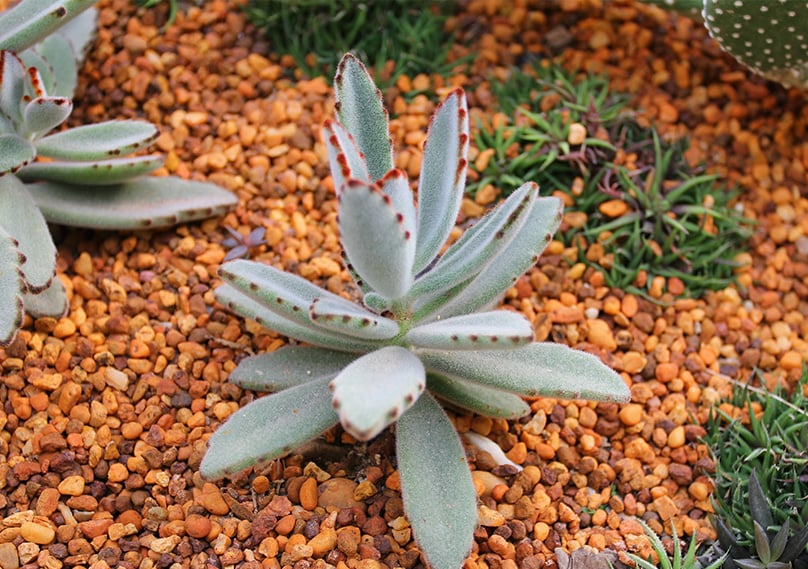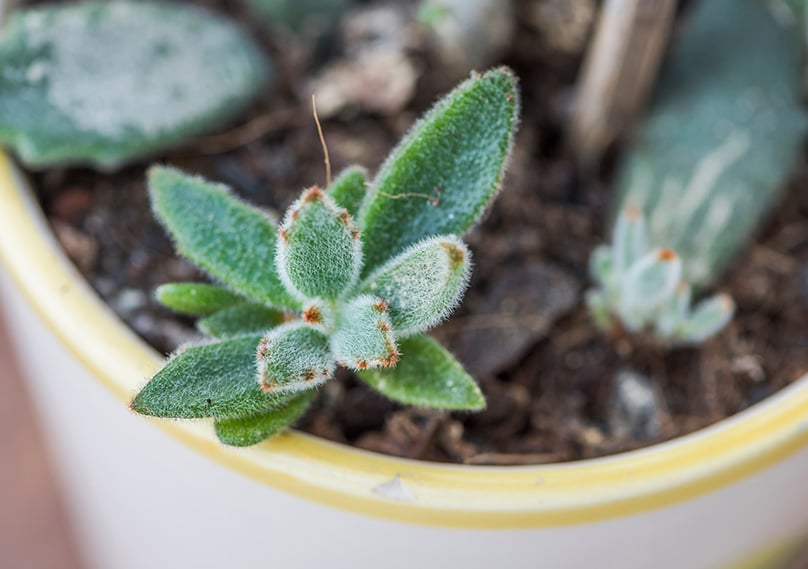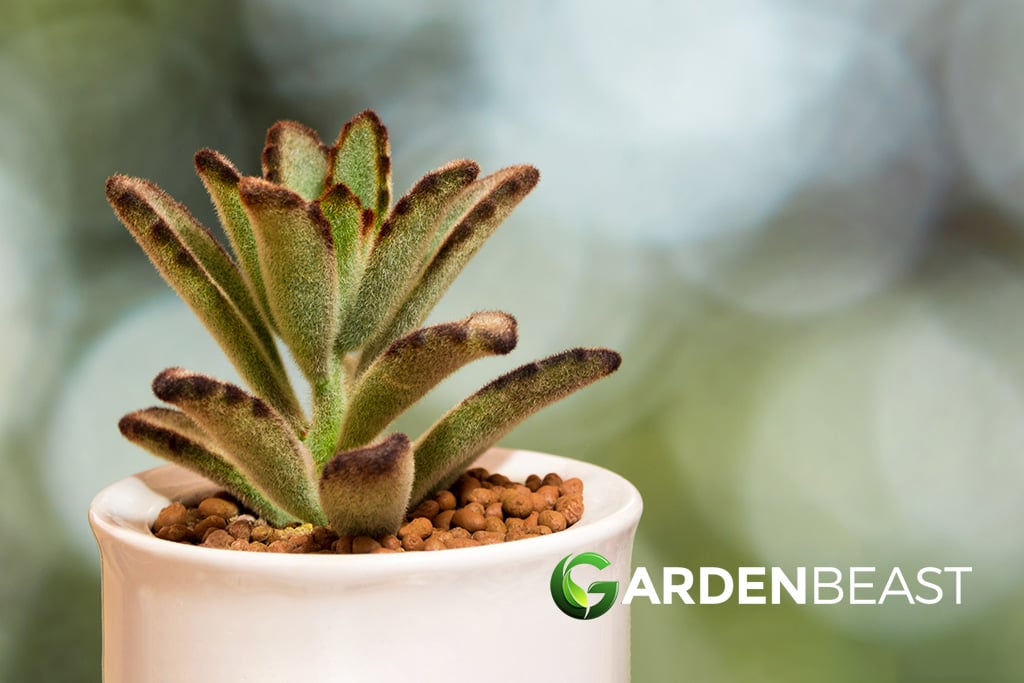The Kalanchoe Tomentosa, also known as Panda Plant or Chocolate Soldier is a great choice if you’re looking for an easy-to-care-for succulent. It has cute leaves with a velvety or furry texture that look like cat ears, so other popular names for the Kalanchoe Tomentosa are Pussy Ears or even Donkey Ears.
Native to Madagascar, wild Panda Plants are usually found on harsh terrain, in rocky soil (granite and gneiss outcrops). In the wild, these succulents can reach heights of several feet but in controlled environments such as indoor gardens, they only reach one or two feet (0.3-0.6 meters).
Although it looks adorable and it is a hardy succulent, the Kalanchoe Tomentosa is toxic for cats and dogs. But if you keep it within a safe distance from your pets, this furry succulent will make a nice addition to your indoor or outdoor collection of succulents.
Kalanchoe Tomentosa Panda Plant, From Amazon
The delicate flowers of the Panda Plant bloom from the tips of the leaves and are tubular-shaped. When grown indoors, the plant will rarely blossom, but if you create a perfect environment for your Panda Plant, you might be lucky enough to see its flowers in spring and summer. But even without flowers, the Kalanchoe Tomentosa is still a unique-looking decorative plant.

Here is our recommended online shops for purchasing succulents & supplies
 Succulents Box
Succulents BoxSucculents Box currently offers more than 200 varieties of succulents (both popular and rare ones) along with 5 monthly subscription boxes.
Visit Store Leaf & Clay
Leaf & ClayLeaf & Clay offer a range of hundreds of types of succulents along with subscription boxes, pots & macrame.
Visit Store Lula’s Garden
Lula’s GardenLula’s Garden offers a selection of succulent garden gift sets from small single succulents in pots to full succulent gardens.
Visit Store The Succulent Source
The Succulent SourceThe Succulent Source offers a huge selection of succulents, cactii and also gift sets and items for weddings.
Visit Store Planet Desert
Planet DesertPlanet Desert cater to succulent and cactii fans with a large range of plants, soil, kits and other supplies for creating your garden.
Visit Store

About Kalanchoe Tomentosa
There are over 100 different types of Kalanchoe plants that grow on the African continent and the Kalanchoe Tomentosa or Panda Plant is one of them.
- Kalanchoe Tomentosa plants belong to the Crassulaceae family and are succulent perennials with thick fleshy leaves, generally covered in fine hairs.
- The island of Madagascar is home to massive Panda Plants that grow as large as 2 feet (60 cm) tall and 2 feet wide.
- The Panda Plant is easy-to-grow and care for in indoor and outdoor gardens and is a perfect choice for children and people who don’t have a lot of gardening experience. It thrives when it has access to direct light, but it doesn’t mind indirect light and it only needs a little water every now and then.
- Like all succulents, Panda Plants shouldn’t be overwatered, so make sure the soil is completely dry before you hydrate it again without leaving water in the bottom tray.
- Kalanchoe Tomentosa can produce branches that trail down so it can be grown in hanging baskets, but most people prefer to grow it in pots.
- Like many other succulents, for optimal growth, the Panda Plant requires a good light/shade balance, a temperature between 60°F and 75°F (15°C and 23°C), and a well-draining succulent soil mix.

Kalanchoe tomentosa “Panda Plant”, From Amazon
Kalanchoe Tomentosa Features: An Overview
- The Panda Plant grows wild in Madagascar where it can reach an average height of 2 feet.
- It has beautiful grayish-green leaves with a furry texture and dark chocolate-colored tips that look like cat ears.
- The Panda Plant has a robust stem that turns woody as the plant matures.
- It has many different names such as Chocolate Soldier, Pussy Ears, Cat Ears, Cocoon Plant, or Donkey Ears.
- Rarely blooms indoors, but if it does, it will happen in spring and summer.
- Thrives in bright light and sunshine, doesn’t mind shade, but it is not cold hardy.
- The Panda Plant is a slow grower and doesn’t need frequent repotting.
- All Kalanchoe succulents are poisonous to birds, cats, and dogs and when ingested will cause vomiting and other digestive problems. If your pet happens to eat a succulent and is showing signs of intoxication, you should take it to the vet.
Growing Kalanchoe Tomentosa
When grown indoors, Panda Plants love bright light, but they also need some shade as they can get scorched by excessive sunlight. So, the perfect spot for this furry succulent is a sunny windowsill that gets a few hours of shade in the morning or afternoon.
If you want to grow Panda Plants in an outdoor garden during summer, the best way to do it is step by step.
As mentioned above, this succulent won’t like direct exposure to bright sunlight and extreme heat, as its leaves might get damaged.
To protect the leaves of the Panda Plant, make sure you place it in a shady and cool environment during the afternoon hours, especially if you live in a warm climate.
Panda Plants have similar requirements with most succulents and cacti. This means that they are quite permissive when it comes to temperature conditions.
The optimal temperatures for growing Kalanchoe Tomentosa are between 60°F (15°C) and 75°F (23°C). They can tolerate temperatures that are slightly lower or higher, but won’t survive frost or excessive heat (unless watered frequently and placed in shady areas).

Watering Kalanchoe Tomentosa Succulents
Low Maintenance succulents such as the Kalanchoe Tomentosa are a perfect choice if you have a busy schedule and tend to forget to water your plants. Most succulents and cacti thrive when they are watered occasionally and the Panda Plant is no exception.
The furry and thick leaves of the Panda Plant store a lot of water and allow the plant to survive for extended periods in extremely dry environments. So you don’t have to worry that your Panda Plant will die if you go on vacation or if you forget to water it for a week or two.
However, you shouldn’t neglect the plant completely and avoid watering it altogether. As soon as you notice that the soil is completely dry, you can water it from above until you notice that the soil is completely damp, or you can pour some water in the bottom tray and wait for it to be absorbed. If you prefer the second option, wait for 10-15 minutes before you remove all the extra water that wasn’t absorbed.

Like most succulents, Panda Plants hate sitting on damp soil for long periods and their roots can easily rot in these circumstances. So overwatering should be avoided and the best way to prevent it is by using cactus and succulent potting mix that has good drainage capabilities, is grainy, and not sticky.
Because it’s a desert succulent, the Kalanchoe Tomentosa doesn’t need fertilizers, but you can feed it twice, in spring and summer (during the growing season) with a diluted liquid succulent fertilizer.
The leaves of the Kalanchoe Tomentosa are quite sensitive to humidity, so you shouldn’t let the water come into contact with them. Wet leaves can rot, so if you accidentally spill some water on them, gently remove as much of it as you can with a tissue.
Common Problems for Kalanchoe Tomentosa Succulents
- Mealybugs – These soft-bodied insects are attracted to Panda Plants as they can easily camouflage on their furry white leaves. The powdery substance that’s produced by mealybugs is very similar in color with the succulent’s leaves. Therefore, it’s recommended to inspect your plants regularly to detect these white little bugs as soon as they appear. If your plants are small and you spot a few mealybugs, the most efficient way to get rid of them is to remove them manually, with a pin. For bigger plants and severe mealybug infestations, you can try ladybugs (general predators that feed on mealybugs), 70% isopropyl alcohol, and neem oil.
- Yellow mushy leaves – Leaves that look damaged and have a yellow mushy aspect are usually a consequence of overwatering. Succulents rot when due to excessive moisture. The good news is that if you notice the first signs early on, pluck the damaged leaves, cut back on watering, and allow the soil to dry completely, the Panda Plants might recover.
Propagating Kalanchoe Tomentosa Succulents
- Propagating Panda Plants is an easy process. All you have to do is cut a few leaves in the growing season (spring or summer), let them dry for a few days, and put them in a container.
- The cuttings should be planted in well-draining soil, ideally a perlite mix or sandy soil.
- The ideal size of the pots for small cutting is approximately 3 inches (7-8cm) and they should get at least six-eight hours of sunlight.
- Panda Plant cuttings usually take root in 3 to 4 weeks and they should be watered as soon as the top 0.8 inch (2 cm) of the soil dries out.
- When the roots appear and you start to notice new growth, the plants should be moved into a larger pot with standard succulent soil mix.
- To encourage growth in your Panda Plants and to ensure that they have a fuller appearance, prune them at the beginning of the growing season.

In Summary
Kalanchoe Tomentosa succulents, AKA Panda Plants, Cat Ears, or Chocolate Soldier are attractive, unique, and low-maintenance perennials.
You can forget to water them once in a while, and they thrive in a balanced environment. If you’re looking to buy a succulent for your child or if you want one for yourself but you don’t have a lot of gardening experience, Panda Plants are a perfect choice.
Just remember not to overwater them and to protect them from extreme temperatures and to keep them away from hungry pets.
